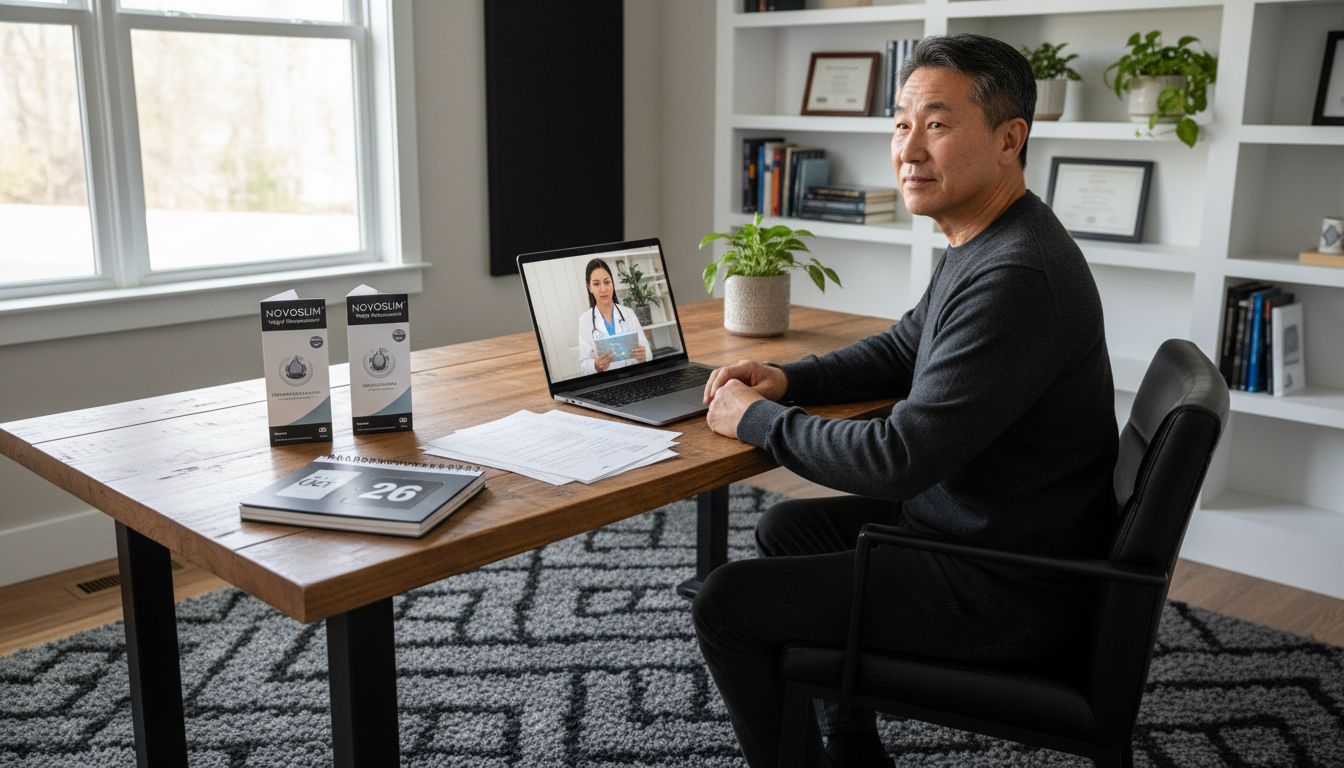Telemedicine Weight Loss Guide: Achieve Results at Home
- Guppy Meds
- Nov 15
- 8 min read

Virtual weight loss care has led to significant improvements in outcomes for adults over 40, according to recent studies. Choosing telemedicine can feel like stepping into the unknown, especially when you want lasting results without endless clinic visits. By breaking down each step from your first assessment to ongoing progress checks, this guide brings clarity and confidence to your telemedicine weight loss journey.
Table of Contents
Quick Summary
Key Point | Explanation |
1. Assess Your Eligibility Honestly | Provide accurate health information to customize your weight management plan effectively. |
2. Prepare for Your Virtual Consultation | Select a quiet space and gather necessary health documents to enhance the consultation’s productivity. |
3. Review Your Personalized Plan Thoroughly | Examine all components of your weight loss strategy and ask questions to ensure clarity and alignment with your goals. |
4. Maintain a Medication and Symptom Journal | Document your medication adherence, side effects, and weight changes to facilitate better follow-up consultations. |
5. Schedule Regular Progress Monitoring | Regular check-ins with your healthcare provider help adjust your weight management strategy based on your ongoing results and needs. |
Step 1: Assess Your Eligibility and Preferences
When starting your telemedicine weight loss journey, the first critical step is understanding whether you are a good candidate for virtual medical weight management. According to a systematic review published in PubMed, telemedicine interventions have shown statistically significant effectiveness for weight loss among adults aged 40 and above, making this an increasingly viable option for many individuals.
To begin your assessment, you will need to gather some key personal health information and consider your specific goals. This typically involves reviewing your current health status, medical history, body mass index (BMI), existing health conditions, and weight loss objectives. Like the assessment process at Rush University Medical Center, the goal is to determine a personalized approach that matches your unique needs.
When evaluating your eligibility, be prepared to provide comprehensive details about your health background. This might include information about previous weight loss attempts, current medications, metabolic conditions, and lifestyle factors. Some key questions you should be ready to answer include your typical diet, exercise habits, stress levels, and any underlying health challenges that might impact your weight loss journey.
A quick pro tip: honesty is paramount during this assessment. The more accurate and transparent you are about your health status, the more effectively healthcare providers can customize a treatment plan specifically for you. Your medical team needs a complete picture to design the most appropriate and safe weight loss strategy.

Once you have completed your initial assessment, you will be one step closer to understanding whether telemedicine weight loss is the right approach for your health goals. The next step will involve a virtual consultation where a licensed healthcare provider will review your information and discuss potential treatment options tailored to your specific needs.
Step 2: Schedule and Attend a Virtual Consultation
Now that you have completed your initial eligibility assessment, it is time to schedule and attend your virtual medical weight management consultation. As demonstrated by Rush University Medical Center, telemedicine appointments offer a convenient and streamlined approach to discussing your weight loss goals from the comfort of your own home.
To begin scheduling your virtual consultation, you will typically need to follow a few simple steps. First, select an available appointment time that fits your schedule. This usually involves accessing an online patient portal or scheduling platform where you can view open time slots and choose a convenient moment for your consultation. During booking, be prepared to provide basic information such as your contact details, medical history, and primary health concerns related to weight management.
On the day of your virtual consultation, ensure you have a quiet private space with a stable internet connection and a device with video capabilities. Prepare a list of questions or concerns you want to discuss with your healthcare provider. Have relevant medical documents, recent lab results, and a record of your current medications readily available. This preparation will help make your consultation as productive and informative as possible.
A pro tip for a successful virtual consultation: test your technology beforehand. Check your internet connection, camera, and audio to prevent any technical difficulties that might interrupt your appointment. Many telemedicine platforms recommend logging in a few minutes early to troubleshoot any potential issues.
After your consultation, your healthcare provider will review your information and develop a personalized weight management strategy tailored to your specific health needs. The next step will involve discussing potential treatment options and creating a comprehensive plan to help you achieve your weight loss goals.
Step 3: Review and Approve Your Personalized Plan
After your virtual consultation, you will receive a comprehensive weight management plan designed specifically for your health needs. According to research from PubMed, telehealth interventions emphasize creating personalized intervention plans that align closely with individual patient preferences and goals.
The personalization process involves carefully reviewing multiple components of your weight loss strategy. As illustrated by Rush University Medical Center, your plan will likely include detailed recommendations such as dietary guidance, exercise protocols, potential medication options, and lifestyle modification strategies. Take time to thoroughly examine each element and ensure it resonates with your personal health objectives and daily routine.
During your plan review, pay special attention to specific details like recommended calorie intake, suggested physical activities, proposed medication treatments, and expected timeline for achieving your weight loss goals. Feel empowered to ask questions or request modifications if certain aspects of the plan seem challenging or unclear. Your active participation and understanding are crucial for successful implementation.
A pro tip for effective plan review: create a list of questions or concerns before your final consultation. This proactive approach helps ensure you address any potential uncertainties and fully comprehend the recommended treatment strategy.
Once you have carefully reviewed and feel comfortable with the proposed plan, you will formally approve it with your healthcare provider. This collaborative approach transforms your weight loss journey from a generic treatment into a personalized roadmap designed exclusively for your success.
Step 4: Initiate Prescription Weight Loss Treatment
With your personalized treatment plan approved, you are now ready to begin your prescription weight loss journey. According to a clinical study published in PubMed, virtual consultations for obesity treatment have been proven to be just as effective as traditional in-person visits, providing a seamless pathway to initiating your weight management medication.
The prescription initiation process typically involves several key steps. Your healthcare provider will submit a prescription to an FDA-registered pharmacy that will handle medication fulfillment and home delivery. You will receive detailed instructions about medication dosage, potential side effects, and optimal administration techniques. Learn more about the weight loss treatment process in our comprehensive step-by-step guide to ensure you have all the necessary information for a successful start.
Pay close attention to the medication instructions and potential interactions with other medications or health conditions. Your healthcare provider will have already reviewed your medical history, but it is crucial that you understand and follow the prescribed regimen carefully. This might include specific timing for medication intake, dietary recommendations, or lifestyle adjustments that complement your treatment.
A pro tip for successful treatment initiation: maintain a medication and symptom journal. Track your dosage, any side effects, weight changes, and how you feel. This documentation will be invaluable during follow-up consultations and helps your healthcare provider fine-tune your treatment plan.
Once your medication arrives, you are set to begin your weight loss journey. The next phase will involve regular check-ins with your healthcare provider to monitor progress, adjust treatment as needed, and provide ongoing support throughout your weight management process.
Step 5: Monitor Progress and Adjust as Needed
As you embark on your weight loss journey, regular monitoring and strategic adjustments become critical for sustainable success. According to research published in JAMA Network Open, telehealth extended care plays a pivotal role in maintaining weight loss, especially for individuals in diverse communities who require personalized ongoing support.
The monitoring process involves scheduling periodic virtual consultations with your healthcare provider to comprehensively review your progress. During these check-ins, you will discuss various metrics including weight changes, medication effectiveness, potential side effects, and overall health improvements. Learn more about the nuanced weight loss treatment process in our comprehensive step-by-step guide to understand the intricacies of this crucial phase.
Expect your healthcare provider to request regular documentation of your weight, measurements, dietary intake, exercise routines, and any physical or emotional changes you experience. As highlighted in research from Current Developments in Nutrition, building a strong rapport during these telehealth consultations is essential for creating a supportive environment that encourages honest communication and collaborative treatment adjustments.
A pro tip for effective progress monitoring: create a digital or physical tracker where you consistently log your weight, measurements, medication details, diet, exercise, energy levels, and any side effects. This comprehensive record provides your healthcare provider with rich insights to fine-tune your treatment plan.

Through consistent monitoring and proactive adjustments, you transform your weight loss journey from a static treatment to a dynamic, responsive process tailored precisely to your evolving health needs.
Take Control of Your Weight Loss Journey with Convenient Telemedicine Solutions
Struggling to find a weight loss plan that fits your busy life and personal health needs can feel overwhelming. This guide explains how telemedicine weight loss programs remove traditional barriers like travel and waiting rooms while providing personalized treatment plans including the latest in prescription medications like GLP-1s. Your challenges of managing diet, exercise, and medication can now be addressed through a streamlined virtual process designed to keep you motivated and informed.

Discover how Guppy Meds can help you start your tailored weight loss treatment with licensed healthcare providers available remotely. Explore our Weight Loss GLP-1’s | Guppy Meds category to find effective options delivered directly to your door. For a broader view of specialized healthcare solutions designed for your lifestyle, visit All Products | Guppy Meds. Begin your journey today with complete privacy, simplicity, and support by visiting Guppy Meds. Don’t wait to experience the convenience and personalized care that fits your unique weight loss goals.
Frequently Asked Questions
How can I assess my eligibility for telemedicine weight loss?
To assess your eligibility, gather key personal health information like your medical history, BMI, and weight loss goals. Review these details carefully to determine if telemedicine is the right fit for you and be honest about your health status.
What should I expect during my virtual consultation for weight loss?
During your virtual consultation, your healthcare provider will review your health information and discuss potential treatment options tailored to your needs. Prepare by having relevant medical documents and a list of questions ready to ensure a productive conversation.
How do I review and approve my personalized weight loss plan?
You will receive a comprehensive weight management plan after your consultation. Carefully examine each component, such as dietary recommendations and medication options, and don’t hesitate to ask questions or request modifications to ensure it aligns with your goals.
What steps should I take to start my prescription weight loss treatment?
To start your prescription treatment, your healthcare provider will submit a prescription to a pharmacy. Follow the detailed instructions provided for medication dose, timing, and any lifestyle adjustments to ensure you begin your weight loss journey effectively.
How should I monitor my progress during the telemedicine weight loss program?
To monitor your progress, regularly schedule virtual check-ins with your healthcare provider to discuss weight changes, medication effectiveness, and overall health improvements. Maintain a detailed log of your weight, diet, and exercise to provide your provider with valuable insights for any necessary adjustments.
How can I ensure a successful virtual consultation experience?
To ensure a successful virtual consultation, test your internet connection and video capabilities before the appointment. Join the meeting a few minutes early, and have your list of questions and relevant medical information on hand to facilitate a smooth discussion.
Recommended
Comments